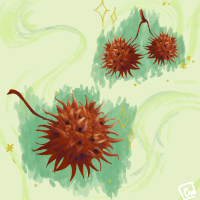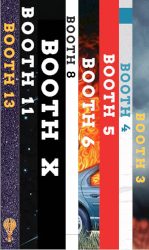We lie on the top bunk of my dorm room, pick out constellations on the walls from blemishes acquired over the decades. The oily remnant of sticky tack. The yellowed outline of brittle scotch tape. An infinite smattering of tiny thumbtack holes. Cobwebs thickened by dust.
I point to a spot on the wall, near where it meets the ceiling. I can make out what looks like an old man with a big nose, wearing a fedora.
“See that face?” I ask.
He turns his gaze, narrows his eyes. “The man in the hat?” “Yes! You see it too?”
He takes his finger, traces the face in the air. “There’s the nose, the chin . . . and here’s his hat.”
We laugh at the absurdity of seeing the same imaginary thing.
*
He lies alone in a polyester-lined coffin. I trace my finger over his face. His lips, pursed and glued shut. His nose. The sprinkle of acne scars across his forehead. The mole above his right eyebrow. I brush my fingertips across his cheek like I’m checking for dust.
I squint my eyes this way and that, trying to make sense of this assortment of facial features. All the pieces are there and seem to fit together, but I don’t see him. I can’t see what’s not there.
*
In an odd coincidence, a childhood friend of his, whom I met at the memorial, lives just three floors below me in the Chicago high-rise I moved into after graduation.
Childhood Friend tells me about a photo he took the night of the wake. “I’ll email it. I think he might be in it . . . you just have to see it.”
The photo was taken outside at night, no flash. It’s mostly black, save for the bright dot of the moon, an orange glow from a distant streetlight painting the barest outline of tree branches.
I turn up the brightness on my laptop, lean in close. Within seconds, I spot his curls, the slant of his nose, the outline of his eyes in a barely illuminated corner of the picture. It’s so clear, that fake pout he puts on for photos sometimes.
I text Childhood Friend. He is here in minutes. I can barely contain my excitement as I pace around, tell him it’s not his imagination, that I too can see his face in the shadows, the one he always made in pictures.
“Wait—you saw a face?”
I stop pacing. “Yeah. Isn’t that what you meant to show me?”
He pulls up the photo on his phone, zooms in on a different spot. “No, I meant this weird shadow. It looks like a person’s standing there, but no one else was at the park that night.”
I look at the weird shadow. It looks like a tree trunk, a utility pole, maybe. “No, that’s not it.” I take his phone, zoom in to the right spot, hand it back.
The moment it clicks, he chucks the phone as if it’s a hot brick. It hits the wall with a thud. He’s trembling, as if he’s just been dunked into ice water.
“I saw him,” he says. He stares blankly at the wall. Hugs his knees to his chest. Still shaking. “What the fuck. What the fuck what the fuck.”
I don’t understand why he seems so rattled.
I pull up the photo on my laptop and stay up all night, staring.
*
A group of us are hanging out at Childhood Friend’s place. Drinking beers, smoking weed, trying to decide whether to go out. The typical conversations among early twenty-somethings. Until I bring up the photo.
“His ghost is in the picture, I swear to god.”
The group turns to Childhood Friend for confirmation. He goes quiet, seems to disappear for a moment. “I don’t know what I saw. But I saw what you saw.”
The photo comforts me through many sleepless nights.
*
Nearly ten years pass. One day, I pull up the photo again. The white dot of the moon, the tangled outline of tree branches. I turn up the brightness on my laptop, lean in close to the screen. I zoom in to the spot near the corner, where his face should be, but I don’t see him. I can’t see what’s not there.



